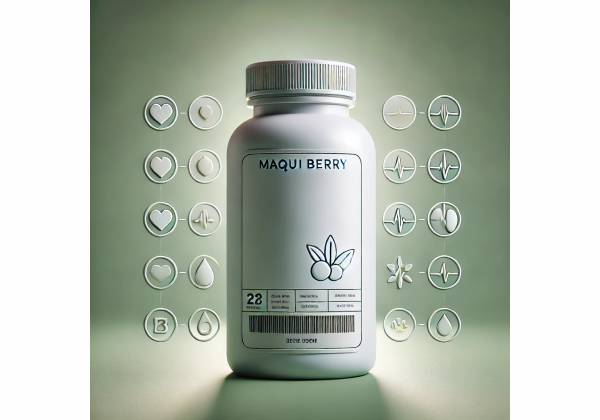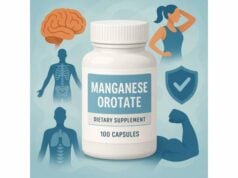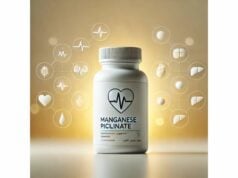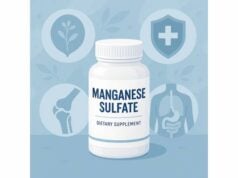
Maqui berry (Aristotelia chilensis) is a deep-purple fruit native to Patagonia, prized for an unusually high concentration of anthocyanins—especially delphinidins—that give it potent antioxidant and anti-inflammatory properties. Modern extracts standardize these compounds to deliver consistent benefits in small daily doses. You’ll see maqui used for metabolic support (healthy glucose and lipids), eye comfort in screen users, exercise recovery, and general oxidative-stress control. Compared with other berries, maqui concentrates a unique delphinidin profile that appears to act rapidly in the gut and bloodstream. Standardized products—sold under names like Delphinol and MaquiBright—have been tested in human trials using 60–180 mg per day for metabolic outcomes and 30–60 mg per day for dry-eye symptoms. This guide translates the evidence into practical steps: what maqui can (and can’t) do, which forms to consider, how to dose, and how to use it safely with other supplements or medications. If you’re choosing between berry powders and clinical-grade extracts, or you just want to know whether maqui belongs in your daily stack, you’re in the right place.
Quick Overview
- Standardized maqui extracts support healthy post-meal glucose and may improve lipid markers at 60–180 mg/day.
- Supplemental maqui can ease dry-eye symptoms and increase tear production at 30–60 mg/day.
- Start with 30–60 mg/day (eye comfort) or 60–180 mg/day (metabolic support); take with water before meals.
- Stop and speak with your clinician if you use diabetes drugs, anticoagulants, or have surgery planned.
- Avoid during pregnancy or breastfeeding and in children unless a clinician recommends it.
Table of Contents
- What is maqui berry and how it works
- Science-backed benefits you can expect
- How to take it: forms and dosages
- Quality metrics: what to look for
- Side effects, interactions, and who should avoid
- Evidence check: what studies show
What is maqui berry and how it works
Maqui (Aristotelia chilensis) is an evergreen shrub native to Chile and Argentina. Its small, dark berries are among the richest natural sources of anthocyanins, with a distinctive dominance of delphinidin glycosides (such as delphinidin-3-O-sambubioside and delphinidin-3-O-glucoside). These pigments are responsible for maqui’s deep color and much of its biological activity.
Why does maqui stand out among berries? Two reasons: concentration and composition. First, maqui’s total anthocyanin content is exceptionally high, delivering more antioxidant capacity per gram than most common berries. Second, its delphinidin-rich profile appears to engage several mechanisms relevant to everyday health:
- Carbohydrate handling in the gut. Standardized maqui extracts have been shown to blunt post-meal spikes by inhibiting sodium–glucose co-transport in the small intestine. Practically, that looks like a lower and later rise in glucose after a carbohydrate-rich meal.
- Vascular and lipid effects. Anthocyanins help maintain nitric-oxide signaling and reduce lipid peroxidation markers, supporting endothelial function and healthier LDL behavior.
- Tear film stability and ocular surface comfort. In eye-health formulas, maqui’s anthocyanins appear to support tear secretion and reduce ocular surface discomfort, useful for people with screen-heavy days.
- Cellular defense. Delphinidins up-regulate endogenous antioxidant systems and suppress pro-inflammatory mediators (e.g., NF-κB signaling), offering systemic resilience against oxidative stress from exercise, UV/blue light exposure, or urban living.
Supplement forms vary. Whole-fruit powders are nutrient-dense but inconsistent in active content. Clinical-grade extracts are standardized—commonly to total anthocyanins (e.g., ≥35%) and delphinidins (e.g., ≥25%)—and used in human trials. Product names you’ll encounter include Delphinol (metabolic focus) and MaquiBright (ocular comfort).
If you want general wellness coverage, either a standardized extract or a well-made powder in smoothies works. If you have a targeted need (post-meal control or dry-eye symptoms), a trial of the specific standardized extract used in studies is the most efficient path.
Science-backed benefits you can expect
1) Smoother post-meal glucose and insulin curves. In controlled research, single doses of delphinidin-standardized maqui extract taken before a carbohydrate load produced a smaller, delayed glucose rise alongside moderated insulin responses. Over several weeks to months, daily intake in at-risk individuals has been associated with improvements in fasting glucose and lipid markers. For someone tracking with a continuous glucose monitor, this often translates into lower peaks and faster returns to baseline after starch-heavy meals.
2) Ocular comfort and tear production. Screen time, low humidity, and contact lens wear strain the tear film. MaquiBright, a maqui extract formulated for eye health, has been evaluated in randomized trials at 30–60 mg/day for four to eight weeks. Participants reported reduced dryness and fatigue, with objective increases in Schirmer test tear volume and improvements in validated symptom scores. The effect isn’t instant; most people notice benefits after two to four weeks of daily use.
3) Oxidative-stress and lipid peroxidation control. Oxidized LDL and F2-isoprostanes are two widely used biomarkers of oxidative stress. In clinical supplementation trials with maqui extract, both markers declined over a month of daily intake. While these outcomes don’t diagnose disease, they indicate a favorable shift in redox balance relevant to cardiovascular and general health.
4) Exercise and recovery support (emerging). Athletes and active people face transient oxidative and inflammatory stress. Anthocyanins can help maintain performance markers and perceived recovery by reducing exercise-induced oxidative damage. Maqui’s delphinidin-rich profile is well suited to this role, and early evidence points in the same direction as other dark-berry extracts.
5) Blue-light and UV resilience (preclinical and pilot human). Photostress from UV and high-energy visible light contributes to ocular surface and retinal strain. Laboratory and pilot clinical data suggest maqui anthocyanins help preserve cellular integrity under light exposure by reducing ROS generation and supporting tear film quality. For office workers or gamers, this is a practical adjunct to environmental fixes (breaks, humidity, screen settings).
What maqui likely doesn’t do: It is not a treatment for diabetes, glaucoma, infections, or structural eye disease, and it isn’t a substitute for protective eyewear or medical care. It also won’t override a high-sugar diet on its own. Think of it as a helpful lever—not a magic one.
Real-world expectations: With consistent use, many people report gentler CGM traces after carbohydrate-rich meals (within days to weeks) and less eye discomfort by weeks two to four. Oxidative-stress markers respond over four weeks or so. If you don’t observe a change by eight weeks at an evidence-based dose, reassess dose, timing, and product quality.
How to take it: forms and dosages
Standardized extracts (capsules or tablets)
These match the compositions tested in clinical studies and are the most efficient choice for targeted goals.
- Metabolic support (post-meal control): 60–180 mg/day of a delphinidin-rich extract (e.g., Delphinol), taken 15–30 minutes before your largest carbohydrate meal. Many begin at 60 mg pre-meal and titrate to 120–180 mg if needed. For multi-meal days, use the dose before the most carb-dense meal.
- Eye comfort (dryness and fatigue): 30–60 mg/day of a maqui extract formulated for ocular use (e.g., MaquiBright), taken with water once daily. For persistent symptoms, some protocols use 30 mg twice daily.
Powders and whole-fruit concentrates
A tablespoon of high-quality maqui powder adds color, polyphenols, and fiber to smoothies or yogurt. Because active content varies, powders are best for general wellness, culinary use, or “stacking” alongside a standardized capsule. If using powder alone, aim for 1–3 grams/day of a lab-tested product, and do not expect the same precision as standardized capsules.
Stacking tips
- For post-meal control: Pair maqui with protein and fiber at the same meal; both strategies are additive. Vinegar or prebiotic fibers taken pre-meal can complement maqui’s intestinal mechanism.
- For eye comfort: Combine with simple environmental changes—20-20-20 breaks, humidifier use, and omega-3 intake—to shore up the tear film from multiple angles.
- For cardiovascular wellness: Maqui plays well with a Mediterranean-style diet, extra-virgin olive oil, and daily movement.
Timing and cycling
- Most people take maqui daily for 8–12 weeks, then reassess. For eye comfort, many continue long-term at 30–60 mg/day. For metabolic goals, you can reserve doses for carb-heavy meals or continue a daily pre-meal routine.
Who benefits most
- Adults with long screen hours, mild dry-eye symptoms, or post-prandial glucose spikes; people seeking an antioxidant adjunct; athletes in heavy training blocks.
Who should get medical input first
- Anyone on glucose-lowering drugs, with bleeding disorders or on anticoagulants/antiplatelets, or planning surgery. If pregnant, breastfeeding, or under 18, use only with clinician guidance due to limited data.
How to evaluate “too much”
- Going far beyond studied ranges (e.g., multiple grams/day of extract) increases the chance of gastrointestinal discomfort without proven added benefit. Stay within 30–60 mg/day for ocular comfort and 60–180 mg/day for metabolic support unless a clinician advises otherwise.
Quality metrics: what to look for
Choosing a maqui supplement is easier when you know the markers of a well-made product. Use this checklist before you buy:
- Standardization on the label. Look for specific polyphenol content—ideally ≥35% total anthocyanins with ≥25% delphinidins—and a named extract (e.g., Delphinol for metabolic support; MaquiBright for eye comfort). Generic “maqui powder” offers no potency guarantee.
- Clinical dose alignment. The serving size should deliver 30–60 mg (ocular) or 60–180 mg (metabolic) in one to two capsules. If a label requires 6–8 capsules to reach 60 mg of extract, look elsewhere.
- Batch testing. Third-party certificates (identity, potency, heavy metals, microbiology, and solvent residues) signal a reputable manufacturer. Look for country of origin and harvest/lot numbers.
- Formulation hygiene. Fewer excipients are better. Avoid unnecessary colorants or sugar alcohols if you’re sensitive. For powders, choose freeze-dried fruit and opaque packaging to protect pigments from light and oxygen.
- Stability and storage. Anthocyanins degrade with heat, light, and humidity. Prefer blister packs or dark bottles with desiccants. Store at room temperature away from direct sunlight; refrigerate powders after opening in humid climates.
- Allergen and dietary fit. Confirm gluten-free and vegan status if relevant. Some products add fish-derived omega-3s for eye formulas—check if you avoid marine ingredients.
- Sourcing transparency. Ethical harvesting from Chilean growers and traceable supply chains reduce adulteration risk and support indigenous communities traditionally connected to maqui.
What marketing claims to ignore
- “Instant blood sugar fix” or “cures dry eye.” Human data show helpful but moderate effects over weeks—not miracles. Avoid brands that promise disease treatment or cite irrelevant animal data as clinical proof.
How to pair with your routine
- If you already use bilberry, blackcurrant, or grape extracts, you don’t need huge maqui doses on top; rotate or choose a single anthocyanin source that aligns with your primary goal. For CGM users, test maqui for two weeks before changing anything else so you can attribute effects properly.
Side effects, interactions, and who should avoid
Typical tolerance
Standardized maqui extracts are generally well tolerated at study doses. The most common complaints—if any—are mild digestive symptoms (bloating, loose stool, or stomach upset) when starting or when taken on an empty stomach with high doses.
Less common issues
Dark-colored stools or urine can occur with high intakes of pigmented polyphenols—benign but surprising. People with a history of kidney stones should moderate any new high-polyphenol supplement and maintain hydration, as a precaution.
Interactions
- Glucose-lowering medications and insulin: Because maqui may reduce post-meal glucose excursions, it can add to the effect of prescription agents. Monitor blood glucose closely when you first combine them and involve your clinician in dose decisions.
- Anticoagulants and antiplatelets: Polyphenols can influence platelet function and vascular reactivity. If you use warfarin or antiplatelet therapy, speak with your prescriber before adding maqui.
- Surgery and procedures: Stop maqui extract 1–2 weeks before planned surgery to minimize theoretical bleeding-risk interactions and to simplify perioperative medication management.
- Iron absorption: Like many polyphenols, maqui could modestly reduce non-heme iron absorption when taken with iron-rich meals or supplements. Separate dosing by 2–3 hours if iron status is a concern.
Special populations
- Pregnancy and breastfeeding: Human safety data are insufficient. Avoid unless your obstetric clinician agrees there’s a specific indication and product quality is verified.
- Children and adolescents: Not routinely recommended; consider only with pediatric guidance for a defined purpose.
- Autoimmune conditions: While anthocyanins are typically anti-inflammatory, any new supplement in autoimmune disease should be introduced cautiously, one change at a time, with symptom monitoring.
When to stop and seek help
- New rashes, breathing difficulty, marked dizziness, persistent GI upset, or unexpected changes in blood sugar, blood pressure, or bruising warrant discontinuation and professional evaluation.
Bottom line on safety
- Stay within 30–60 mg/day (ocular) or 60–180 mg/day (metabolic). Introduce gradually, take with water (and a small snack if your stomach is sensitive), and coordinate with your clinician if you use chronic medications or manage a medical condition.
Evidence check: what studies show
Metabolic outcomes (post-meal and fasting control)
Single-dose and multi-week human studies using delphinidin-standardized maqui extract taken before carbohydrate intake report improved post-prandial glucose curves and, over time, favorable shifts in fasting glucose and lipid markers in people with impaired glucose regulation. The proposed mechanism—partial inhibition of intestinal sodium–glucose co-transport—helps explain why taking maqui before a carb-rich meal is more effective than after eating. Doses typically range from 60 to 180 mg/day, with some protocols timing intake 15–30 minutes pre-meal.
Oxidative-stress biomarkers
Randomized, double-blind, placebo-controlled work has shown reductions in oxidized LDL and urinary F2-isoprostanes after four weeks of maqui extract. These markers improve redox status but are not direct disease endpoints, so they’re best viewed as supportive evidence for cardiovascular and general wellness strategies.
Eye comfort and tear function
In ocular studies, MaquiBright at 30–60 mg/day for four to eight weeks increased tear production (Schirmer test) and reduced symptoms like dryness, eye fatigue, and shoulder stiffness in screen users. A recent clinical analysis also reported improvements in signs and symptoms of dry-eye disease alongside reductions in inflammatory mediators in tear fluid. As with most nutraceutical trials, samples are modest, but the consistency across studies and alignment with mechanisms (antioxidant action, epithelial support) strengthen confidence.
Blue-light and photostress data
Preclinical and translational research suggests maqui anthocyanins—especially delphinidins—help protect ocular tissues exposed to blue light and UV by limiting reactive oxygen species and supporting mitochondrial function. These findings support, but do not replace, real-world countermeasures like regular breaks, environmental humidity, and optimized screen settings.
What the evidence doesn’t show
There are no large, long-term outcome trials proving maqui prevents diabetes, cardiovascular events, or chronic eye disease. The best-quality evidence supports symptom relief (dry eye), improved oxidative-stress markers, and healthier post-meal glucose dynamics. Use maqui as part of a broader plan: diet quality, sleep, physical activity, environmental ergonomics, and medical therapy when indicated.
How to use the evidence in practice
- If you’re targeting post-meal spikes, begin with 60 mg delphinidin-standardized extract 15–30 minutes before your main carbohydrate meal; titrate to 120–180 mg if CGM or finger-stick readings still show large excursions.
- For screen-related dryness, choose a product explicitly labeled for ocular use and take 30–60 mg/day for at least 4 weeks before judging effect. Add humidification and work-break hygiene for best results.
- Reassess at 8 weeks. If there’s no meaningful change at evidence-based doses with a verified product, consider discontinuing or changing focus.
References
- Delphinol® Standardized Maqui Berry Extract Reduces Postprandial Blood Glucose Increase in Individuals with Impaired Glucose Regulation by Novel Mechanism of Sodium Glucose Co-Transporter Inhibition 2014 (RCT/Mechanistic)
- Delphinidin-Rich Maqui Berry Extract (Delphinol®) Lowers Fasting and Postprandial Glycemia and Insulinemia in Prediabetic Individuals 2016 (Clinical Trial)
- Effects of MaquiBright® on improving eye dryness and fatigue in humans: A randomized, double-blind, placebo-controlled trial 2019 (RCT)
- Effect of maqui-berry extract in dry eye disease 2023 (Clinical Study)
- A Review of the Functional Characteristics and Applications of Aristotelia chilensis (Maqui Berry), in the Food Industry 2024 (Systematic Review)
Disclaimer
This article provides general educational information about maqui berry and is not a substitute for professional medical advice, diagnosis, or treatment. Always talk with your qualified healthcare provider before starting any new supplement, especially if you have a medical condition, take prescription medications, are pregnant or breastfeeding, or are planning a medical or dental procedure. Never delay seeking medical advice because of something you read here.
If you found this guide helpful, consider sharing it with a friend or colleague on Facebook, X (formerly Twitter), or your favorite platform, and follow us for more evidence-based wellness content. Your support helps us keep producing high-quality articles.










